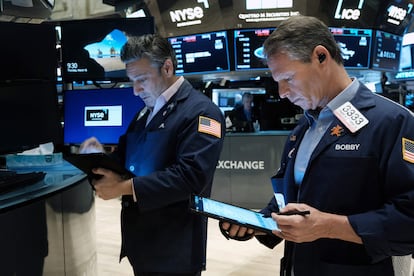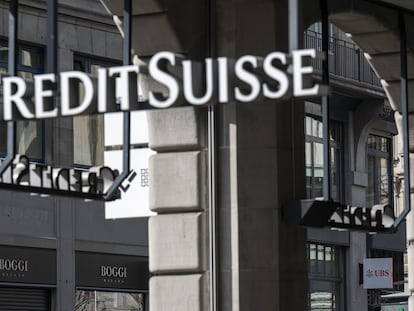The poker game threatening the world economy
The fall of SVB has caused multi-billion dollar losses around the world and will weigh on the economy, but experts believe that authorities can contain the damage


It’s the early 1980s. A group of friends meet at a house near the beach to play poker in Pajaro Dunes (California). Some win and some lose, but all of them decide to participate in the creation of a new bank to provide service to companies in the area, which is quickly becoming known as Silicon Valley. They choose that same name for the new lender, without being yet aware that it will be their best branding decision. That game played over 40 years ago has cost investors around the world tens of billions of dollars this past week and is testing regulators’ ability to prevent financial turmoil from escalating into a full-blown economic crisis.
The experts consulted for this story believe that authorities will be able to contain the contagion because they have tools ready from previous crises. Still, they acknowledge that the likelihood of a U.S. recession has increased. The global impact for now is minor, and nobody expects a financial crisis like the one in 2008, triggered by the collapse of the U.S. mortgage bubble. This time, the trigger has been the most aggressive interest rate hikes since the early 1980s — just when Silicon Valley Bank was being created.
The fall of Silicon Valley Bank
The crisis broke out after the bank that lent to start-ups and venture capital firms put its cards on the table. In early March, ratings agency Moody’s had quietly warned bank officers that they were considering a downgrade. The reason was that SVB had invested significant amounts of its clients’ deposits in government bonds, which in theory are very safe, but which had lost value with the sharp rises in interest rates approved by the Federal Reserve last year to combat inflation. Silicon Valley Bank hired Goldman Sachs and sold it a portfolio of bonds, in a move that entailed materializing previously unrealized losses worth €1.8 billion. It also decided to embark on a $2.25 billion capital increase to reinforce its liquidity. It thought it had a winning hand.
The execution of the operation was disastrous. The presentation to analysts made by SVB on March 8 shows how out of touch bank officials were from the reality that was about to hit them. The bank was selling the strategy designed with Goldman Sachs as a way to improve its own results. At that point, it was not trying to raise money because it needed liquidity to pay back depositors, but to defend its credit rating and reinvest it in securities with higher interest rates.
In the prospectus for the operation, Silicon Valley Bank acknowledged that deposits were lower than expected because clients, mainly tech companies, were consuming more cash. The bank decided to sell its debt portfolio first, which meant materializing its unrealized losses, and wait for the next day to issue new shares. This was a big blunder: “The delay in capital increase opened a window for panic on Thursday to which the SVB was vulnerable, with more than 95% of deposits uninsured and a deposit base concentrated in venture capital-backed companies, all of which caused large outflows,” explain Citibank analysts, who describe the fall of the bank as “self-inflicted.”
SVB shares tumbled on the stock market at the opening of Thursday’s session. The lender failed to find buyers for its new shares. Deposit withdrawals broke records for amount and speed. Customers demanded $42 billion back within the space of a few hours. The concentration of deposits in a single sector, the fact that the vast majority of deposits were uninsured and herd behavior made the prophecy self-fulfilling.
No bank has the liquidity to return the money if all its customers request it at the same time. That is why bank runs are so dangerous. In addition, deposit runs are no longer in the style of It’s a Wonderful Life, the 1946 film in which James Stewart plays George Bailey, an honest banker who decides to commit suicide after a large amount of money goes missing. In the digital age, you don’t even need lines of customers outside the bank, just transfer orders given on cellphones and computers. Nor is there the option of a George Bailey telling everyone to remain calm. On the morning of March 10, authorities stepped in. After almost 40 years of existence, Silicon Valley Bank disappeared in about 40 hours.
It was the largest bank failure since the fall of Washington Mutual in 2008 and the second largest in the history of the Federal Deposit Insurance Fund (FDIC). This body was created after the Great Depression, after some 9,000 entities disappeared between 1930 and 1933 due to bank runs. By guaranteeing deposits up to a certain amount, citizens no longer need to run for their money at the slightest sign of trouble.
Contagion effect
After the SVB intervention, the contagion effect began immediately. That same Friday, shares of other medium-sized banks in the United States fell and there were more deposit runs. The Treasury Department, the FDIC and the Federal Reserve began to analyze how to contain the crisis. On Sunday night (echoing events from the previous financial crisis) they announced the intervention of another lender, Signature Bank, and said the federal guarantee was being extended to 100% of the deposits of both banks, something that can only be done exceptionally by declaring a situation of systemic risk.

The characteristics of Silicon Valley Bank, with its concentration of venture capital clients, and Signature Bank, with its exposure to cryptocurrencies, were unique, but regulators had recently estimated that the banks had some $620 billion of unrealized losses in their portfolios due to increases in interest rates on government bonds. Along with guaranteeing the deposits of the two failed entities, the Fed approved a measure to provide liquidity to other banks for the original value of the bonds, as if they carried no losses, in a bid to prevent new deposit leaks.
Authorities fired the banks’ managers, and made it clear that they would not protect shareholders or bondholders (“That’s how capitalism works,” said U.S. President, Joe Biden). In practice, they bailed out depositors, including some investment firms that openly renounce public intervention in the economy. Biden has called for tougher penalties for bankers of failing entities and has blamed his predecessor, Donald Trump, for relaxing the supervision of midsize banks. Both Biden and Treasury Secretary Janet Yellen have insisted that the financial system is sound. The Federal Reserve has set out to investigate what has gone wrong and why its supervisory efforts were unable to prevent the risks that have materialized.
Banks around the world, including European ones, have suffered on the stock market since Monday. There are various routes of contagion on a continuum that goes from direct exposure to fallen banks to irrational fear. But Credit Suisse was hit squarely by the shock wave, partly because of its own blunders. The bank had been dragging problems for years, but on Tuesday it published its annual report and recognized “relevant weaknesses” in its financial information control systems.
It’s never a good time to say something like that, but doing it in the middle of a storm... To top it off, on Wednesday the president of Saudi Arabia’s SNB, Credit Suisse’s largest shareholder, was asked if he would be willing to increase his stake in the Swiss entity. Instead of giving vague assurances, he said, “Absolutely not.” Credit Suisse’s collapse was immediate.
After a multimillion-dollar liquidity lifeline provided in the early hours of Thursday, Swiss authorities worked through the weekend to find a solution. On Sunday it was announced that banking giant UBS is buying Credit Suisse for almost $3.25 billion, in a deal orchestrated by regulators in an effort to avoid further market-shaking turmoil in the global banking system.
Ready to act
The good news is that authorities have their toolbox at hand. The 2008 financial crisis, the euro crisis and the Covid pandemic have meant that central banks and policymakers are well trained, know what to do, and how to do it.
“That mental block that sometimes aggravates crises has been avoided. Authorities do not like bailouts because of the moral hazard involved, they tend to wait until there is clear suffering, until it is clear that there is no other remedy, and it ends up being worse. This time they have reacted very quickly. In two days, many people have gone from finding out that there was a bank called Silicon Valley Bank to knowing that it was intervened, with guaranteed deposits,” says an executive from one of the largest investment firms in the United States, speaking from New York. This source also highlights the speed at which the Federal Reserve has implemented a tailored mechanism to respond to possible liquidity leaks.
“Although there is no doubt that banking problems will attract attention, we believe that it is not a systemic problem, but rather a liquidity problem that the Federal Reserve can contain with its lending mechanisms,” said experts at Oxford Economics. “It may seem like another financial crisis, but it is not.”
In Europe, the European Central Bank (ECB) has raised interest rates while ensuring that it sees no risk of contagion and guarantees that it is prepared to deal with liquidity problems. “The expected rise of 50 basis points comes with a warning about risks to financial stability. That said, the banking system shows no weaknesses or significant exposure to troubled foreign institutions,” summarized Axel Botte, global market strategist at Ostrum AM.

Eurozone banks have lower exposure to fixed-income securities, more stable deposit bases and tighter interest rate risk regulation, even for smaller banks. In any case, as María Rivas of DBRS Morningstar warned, “the recent bankruptcies show that bank runs and liquidity crises can develop at a speed never seen before.” For this reason, she advocates for more tools to deal with liquidity crises.
Economic ballast
The financial storm is following a long tradition: falls in the stock market, regulator intervention, weekend action, shock, relief... But it is also a tradition that banking crises take their toll on the economy. Michael Hartnett, an investment strategist at Bank of America, points out that since 1870 there have been 14 major global recessions, all caused by wars, pandemics and banking crises. This time, with the world recovering from a pandemic, a war has fueled inflation and rate hikes have contributed to a (so far small) banking crisis, but it is not yet clear what its effect will be.
“The U.S. economy will eventually slow down, probably a bit sooner than expected after these events, but it could still take a while,” says Vincent Vinatier, a portfolio manager at AXA Investment Managers, in a cautious forecast.
“Nobody knows, nor can they know yet,” says an economist from a U.S. investment giant, explaining that deposits have been transferred from some lenders to other lenders and that it is not clear how intense the credit restriction will be. What does seem clear is that downside risks have increased, as has the probability of a recession, which Goldman Sachs has raised to 35%.
“These events could lead to a recession,” agrees Tiffany Wilding, US economist at PIMCO. In her view, there are very good reasons to believe that credit growth, which was already slowing, will slow further. “Regional banks are likely to show greater risk aversion, at least in the short term,” she says. “It is hard to believe that these banks, fearing a possible sudden outflow of deposits, will not tighten their lending rules.”
The Federal Reserve is also likely to tighten regulation and supervision of large regional banks, indirectly restricting credit. Even so, the United States has been announcing an imminent recession for almost a year and it hasn’t quite arrived. The labor market has shown great resilience. The Fed intends to cool demand to combat inflation and this episode of instability could make it necessary to raise rates a little less, although it does not change the economic outlook excessively (at least for now).
Something similar is happening in the rest of the world. Obviously, recent events are not good news and the risks have increased, but it is too soon to gauge a real impact on the global economy. Emerging countries, and Latin American ones among them, are in a little more danger: “The financial turmoil in the United States after the bankruptcy of two regional banks has increased volatility and has caused the value of Latin American assets to fall. The episode of risk aversion has not changed our baseline forecast, but it has highlighted the region’s sensitivity to a severe tightening of financial conditions,” said analysts at Oxford Economics.
Experts at the International Monetary Fund (IMF) are working these days to adjust their world economic forecasts. They will present their conclusions in less than a month. If the damage in the U.S. remains superficial, the impact on the rest of the world should not be great. The next few days may be key.
It’s not yet clear that the private bailout by big Wall Street banks of First Republic Bank, another San Francisco-based regional bank with $30 billion in deposits, has worked. First Republic has continued to lose value on the stock market after the injection. The operation has been led by Jamie Dimon, the president of JP Morgan Chase, who in doing so honored the founder John Pierpont Morgan — who orchestrated the response to the financial panic of 1907, committing his own money to the effort because he realized that it was in the interest of the entire industry to support its weakest links. Banks live on trust, and for bankers it must not have been very pleasant to see that Bitcoin has skyrocketed this week due to money fleeing banks in search of other safe havens.
Sign up for our weekly newsletter to get more English-language news coverage from EL PAÍS USA Edition
Tu suscripción se está usando en otro dispositivo
¿Quieres añadir otro usuario a tu suscripción?
Si continúas leyendo en este dispositivo, no se podrá leer en el otro.
FlechaTu suscripción se está usando en otro dispositivo y solo puedes acceder a EL PAÍS desde un dispositivo a la vez.
Si quieres compartir tu cuenta, cambia tu suscripción a la modalidad Premium, así podrás añadir otro usuario. Cada uno accederá con su propia cuenta de email, lo que os permitirá personalizar vuestra experiencia en EL PAÍS.
¿Tienes una suscripción de empresa? Accede aquí para contratar más cuentas.
En el caso de no saber quién está usando tu cuenta, te recomendamos cambiar tu contraseña aquí.
Si decides continuar compartiendo tu cuenta, este mensaje se mostrará en tu dispositivo y en el de la otra persona que está usando tu cuenta de forma indefinida, afectando a tu experiencia de lectura. Puedes consultar aquí los términos y condiciones de la suscripción digital.
More information
Archived In
Últimas noticias
Most viewed
- Sinaloa Cartel war is taking its toll on Los Chapitos
- Oona Chaplin: ‘I told James Cameron that I was living in a treehouse and starting a permaculture project with a friend’
- Reinhard Genzel, Nobel laureate in physics: ‘One-minute videos will never give you the truth’
- Why the price of coffee has skyrocketed: from Brazilian plantations to specialty coffee houses
- Silver prices are going crazy: This is what’s fueling the rally










































